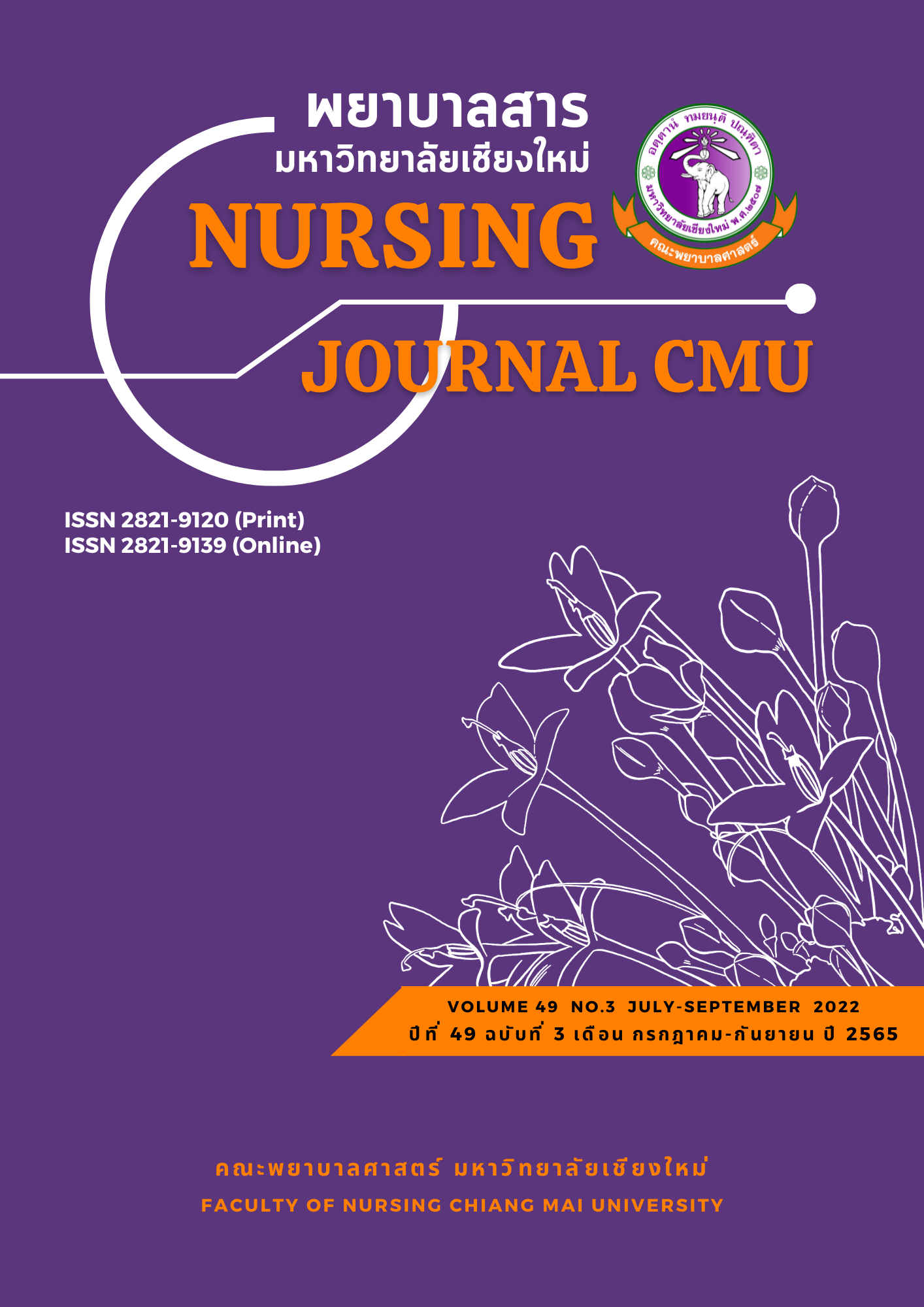Carbohydrate Intake and Hemoglobin A1c in Older Adults with Type 2 Diabetes Mellitus
Keywords:
Carbohydrate intake, Hemoglobin A1c, Older adults, Type 2 diabetes mellitusAbstract
Older adults with type 2 diabetes mellitus require a controlled diet to prevent subsequent complications. This research aimed to describe carbohydrate intake, hemoglobin A1c and the relationship between carbohydrate intake and hemoglobin A1c in older adults with type 2 diabetes mellitus. The sample consisted of 88 older adults diagnosed with type 2 diabetes mellitus attending the health promotion hospital in Ban Tom and Mae Ka Sub-District, Muang District, Phayao Province. The sample was purposively selected based on the eligibility criteria. Data were collected using: 1) A 7-day Food Diary Record which was used to determine carbohydrate intake using the Nutrifacts Program software, and 2) a hemoglobin A1c analyzer. The validity and reliability of these instruments were approved prior to data collection. Data were analyzed using descriptive statistics, and Pearson’s product-moment correlation.
The study results revealed that:
- Older adults with type 2 diabetes mellitus had an average carbohydrate intake of 405.04 grams/day, representing average carbohydrate energy of 1278.72 kilocalories/day which accounted for 65.59% of total energy (1949.57 kilocalories).
- Older adults with type 2 diabetes mellitus had average hemoglobin A1c of 7.60%. About two-thirds (65.91%) of the sample had hemoglobin A1c above the control level (≥ 7%); and
- Carbohydrate intake showed a positively significant relationship with hemoglobin A1c at a moderate level (r = .49, p < .05).
The findings can be used as information for health personnel to promote carbohydrate consumption control in older adults with type 2 diabetes mellitus.
References
American Diabetes Association. (2020). Standards of medical care in diabetes-2020. Diabetes care, 43(Supplement 1), 1-212.
Barclay, A. W., Petocz, P., McMillan-Price, J., Flood, V. M., Prvan, T., Mitchell, P., & Brand-Miller, J. C. (2008). Glycemic index, glycemic load, and chronic disease riska meta-analysis of observational studies. American Journal of Clinical Nutrition, 87(3), 627-637.
Bureau of Policy Strategy. (2015). Public health statistics A.D. 2015. Retrived from https://dohdatacenter.anamai.moph.go.th (in Thai)
Cohen, J. (1988). Statistical power analysis. Current Directions in Psychological Science, 1(3), 98-101.
Dankul, P., Suwichacherdchu, P., & Tongpenyai, N. (2011). Association between personal self-care behavioral and supportive factor and blood glucose control of type-2 diabetic patients at primary care units (PCUs) of CUP Maung-Ya 5 network. The Journal of Boramarajonani College of Nursing Nakhon Ratchasima, 17(2), 27-38. (in Thai)
Deerochanawong, C., & Ferrario, A. (2013). Diabetes management in Thailand: A literature review of the burden, costs, and outcomes. Global Health, 9(11), 1-18. doi: 10.1186/1744-8603-9-11 (in Thai)
Farvid, M. S., Homayouni, F., Shokoohi, M., Fallah, A., & Farvid, M. S. (2014). Glycemic index, glycemic load and their association with glycemic control among patients with type 2 diabetes. European Journal of Clinical Nutrition, 68(4), 459-463.
Foundation for the Promotion of Nutrition and Health Sciences, Research Institute, Chiang Mai University. (2014). Development program to calculate the nutritional value of traditional Lanna Thai food. (n.p.).
Gannon, M. C., & Nuttall, F. Q. (2004). Effect of a high-protein, low-carbohydrate diet on blood glucose control in people with type 2 diabetes. Diabetes, 53(9), 2375-2382.
Gray, A., Threlkeld, R. J. (2019). Nutritional recommendations for individuals with diabetes. Retrived from https://www.ncbi.nlm.nih.gov/books/NBK279012/
Intharabut M., Muktabhant, B. (2007). Perception and practices of dietary control in type 2 diabetic patients. Srinagarind Medical Journal, 22(3), 283-290. (in Thai)
International Diabetes Federation. (2019). IDF diabetes atlas (9th ed.). Retrived from https://www.diabetesatlas.org
Kahn, R. L., Goldfarb, A. I., Pollack, M., & Peck, A. (1960). Brief objective measures for the determination of mental status in the aged. American Journal of Psychiatry, 117(4), 326-328.
Kieudee, S., & Saengrut, B. (2020). Carbohydrate consumption among uncontrolled type 2 diabetes mellitus patients in diabetec clinic, Maharaj Nakorn Chiang Mai Hospital. Chiang Mai Medical Journal, 59(4), 227-239. (in Thai)
Kirk, J. K., Graves, D. E., Craven, T. E., Lipkin, E. W., Austin, M., & Margolis, K. L. (2008). Restricted-carbohydrate diets in patients with type 2 diabetes: A meta-analysis. Journal of the American Dietetic Association, 108(1), 91-100. doi:10.1016/j.jada.2007.10.003
Pablos-Velasco, P., Parhofer, K. G., Bradley, C., Eschwege, E., Gönder-Frederick, L., Maheux, P., ... & Simon, D. (2014). Current level of glycaemic control and its associated factors in patients with type 2 diabetes across Europe. Clinical Endocrinology, 80(1), 47-56.
Polit, D. F., & Beck, C. T. (2004). Nursing research: Principle and methods (7th ed.). Philadelphia: Lippincott Williams & Wilkins.
Sato, J., Kanazawa, A., Makita, S., Hatae, C., Komiya, K., Shimizu, T., ... Watada, H. (2016). A randomized controlled trial of 130 g/day low-carbohydrate diet in type 2 diabetes with poor glycemic control. Clinical Nutrition, 36(4), 992-1000. doi:10.1016/j.clnu.2016.07.003
Siriwattanapornkul, T., Oba, N., & Na Rachasima, I. S. (2007). Factors related to blood glucose level among patients with diabetes mellitus Type II. Journal of Nursing Science Naresuan University, 1(2), 57-67. (in Thai)
Suwankruhasn, N., Pothiban, L., Panuthai, S., & Boonchuang, P. (2013). Effects of a self-management support program for Thai people diagnosed with metabolic syndrome. Pacific Rim International Journal of Nursing Research, 17(4), 371-383.
Welch, A., Hayhoe, R., & Cameron, D. (2020). The relationships between sarcopenic skeletal muscle loss during ageing and macronutrient metabolism, obesity and onset of diabetes. Proceedings of the Nutrition Society, 79(1), 158-169. doi:10.1017/S0029665119001150
Downloads
Published
How to Cite
Issue
Section
License
Copyright (c) 2022 Nursing Journal

This work is licensed under a Creative Commons Attribution-NonCommercial-NoDerivatives 4.0 International License.
บทความที่ได้รับการตีพิมพ์เป็นลิขสิทธิ์ของวารสารพยาบาลสาร
ข้อความที่ปรากฏในบทความแต่ละเรื่องในวารสารวิชาการเล่มนี้เป็นความคิดเห็นส่วนตัวของผู้เขียนแต่ละท่านไม่เกี่ยวข้องกับมหาวิทยาลัยเชียงใหม่ และคณาจารย์ท่านอื่นๆในมหาวิทยาลัยฯ แต่อย่างใด ความรับผิดชอบองค์ประกอบทั้งหมดของบทความแต่ละเรื่องเป็นของผู้เขียนแต่ละท่าน หากมีความผิดพลาดใด ๆ ผู้เขียนแต่ละท่านจะรับผิดชอบบทความของตนเองแต่ผู้เดียว






